As the frog will tell you, reaching new highs does come with risks…
Instead of talking about the broad based indexes trading to new all-time highs last week on better than expected data in Housing Prices, New Home Sales, Durable Goods, Chicago PMI, UofMichigan Confidence, and the pickup in bank lending and M2 growth, there is only 1 thing that matters to the markets: Russia. While the Ukrainian situation has little impact on the sales of iPhones, Teslas or Cool Ranch Doritos Locos Tacos, the threat of war will impact most all equity prices as risk is removed from the financial markets. So if you are a Long Only investor, you build your favorite company lists, watch prices closely and wait to pounce when you think that the weapons will be re-holstered. For Longs, it is unfortunate timing because junk bonds continued to run, bank stocks just had a great week, Treasury bond prices were stable and the global M&A trade continued to gobble up companies. The fuel for higher prices is ready to be deployed as soon as Ukraine leaves the front page of the leading newspapers and websites.
A good chart here showing the big reversal in fortune in Friday’s trading…
Those names that led the gains in February also led the Russian/Ukrainian risk off decline on Friday. This is an expected move by investors who took the chips off the table where they just made the largest gains. When Ukraine settles, I’d expect the biggest decliners Friday to attempt to reclaim their leadership over the markets.
Good news for the World’s largest sovereign wealth fund which is being forced to sell equities because they have hit their allocation maximum.
Norway’s sovereign wealth fund, the world’s largest, gained 692 billion kroner ($115 billion) last year as stocks rallied, forcing it to pare its equity holdings for the first time ever to comply with risk mandates. The Government Pension Fund Global returned 15.9 percent in 2013, after rising 13.4 percent the year before, the Oslo-based investor said today. The $840 billion fund’s stocks returned 26.3 percent, while its bond investments climbed 0.1 percent. Real estate investments gained 11.8 percent. It was a net seller of stocks as it adjusted holdings to comply with the government’s 64 percent limit on equities in its portfolio and sold 150 billion kroner in the fourth quarter. The fund follows a rebalancing strategy where it buys assets that fall in price and sells as they rally. “This was the first time that rules-based rebalancing of the equity allocation in the fund’s benchmark index has been triggered,” the investor said. “The adjustment of the actual portfolio will take place over a longer period but the fourth quarter of 2013 was still the first in the fund’s history when we sold more shares than we bought, and this was despite significant inflows of new capital.”
If you have been looking to increase your fixed income exposures, some top investing minds are buying discarded closed end bond funds…
Hedge-fund firms Saba Capital Management LP and Pine River Capital Management are piling into closed-end debt funds with share prices that plunged below the value of their assets by the most since the credit crisis. Saba, the $3.9 billion manager run by Boaz Weinstein, has amassed at least $847.3 million in the publicly traded funds after it started buying them last year, moving into an area traditionally dominated by individual investors, regulatory filings show. Pine River purchased $159.6 million of shares that on average fell as much as 9.1 percent below their holdings in December, the biggest gap since 2009 as measured by Thomas J. Herzfeld Advisors Inc. Hedge-fund managers are seeking an edge in a market where the riskiest corporate debt is typically yielding 6.06 percent, 3 percentage points less the average of the past decade. They’re stepping into funds run by BlackRock Inc. (BLK) and Pacific Investment Management Co. after retirees and wealthy individuals fled last year in the face of a Federal Reserve pullback from unprecedented stimulus.
One reason closed end bond funds are trading at discounts is due to Individual Investors increasing their interest in equities…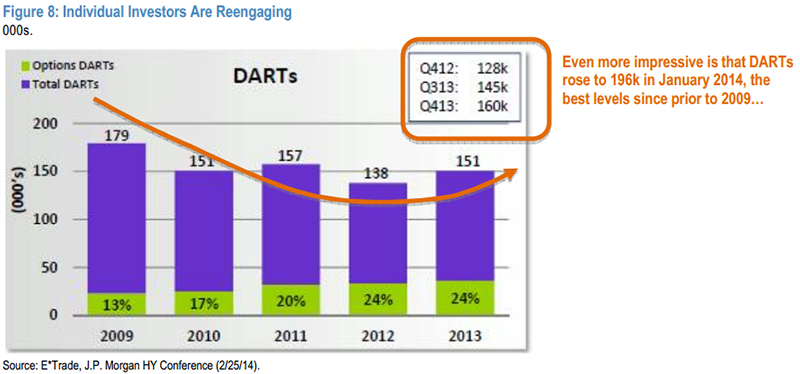
On Russia, it looks as if they will do anything to protect their many interests in Crimea…
Today’s Crimea does not want independence from Ukraine; it wants continued dependence on Russia. Traditionally the gem in the imperial crown, a lavish playground of czars and Soviet commissars – and, more important, the home of the Russian Navy’s Black Sea Fleet – Crimea became part of Ukraine under Nikita Khrushchev in 1954. After the Soviet Union collapsed in 1991, Russian President Boris Yeltsin apparently forgot to claim it back, so Ukraine kept a territory in which nearly 60% of the two million inhabitants identify as Russians. In defense of Khrushchev (my great-grandfather), whether Crimea was part of Russia or Ukraine hardly mattered. After all, they were all part of the Soviet empire. But in the last 20 years, Russia has sought to retake the peninsula.
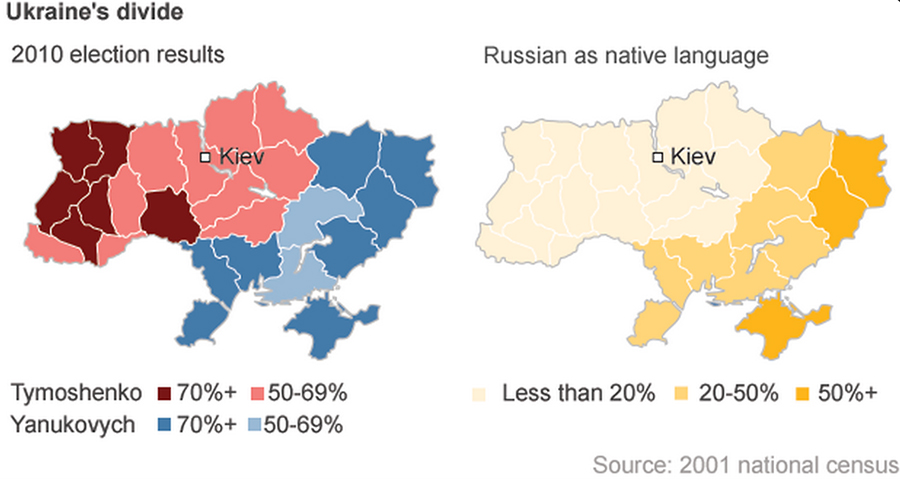
But Western Ukraine will need to learn how to get along with Russia for both of their economic interests. Look at all of the Russian natural gas flowing through those Ukrainian pipelines to Europe. You guessed right that the EU is intent on finding a solution.
@StefSimanowitz: 66% of Russian gas exported to the EU transits Ukraine (37% of Germany’s gas / 27% Italy’s / 27% France’s) via @afp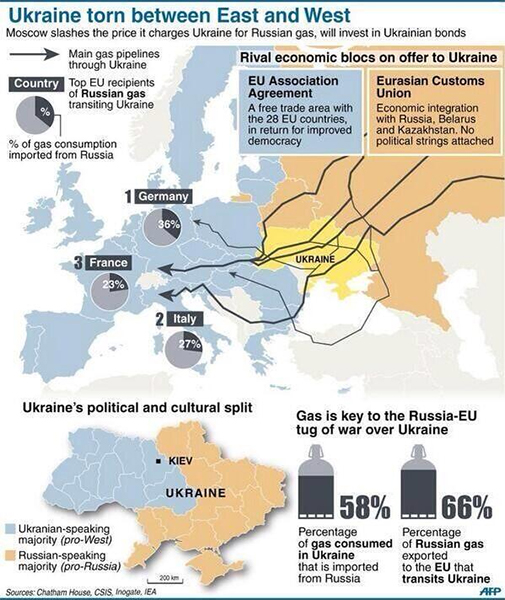
Even with Russian fears hitting Friday afternoon, the equity markets had a good week…
Even around the globe, most all asset classes gained on the week…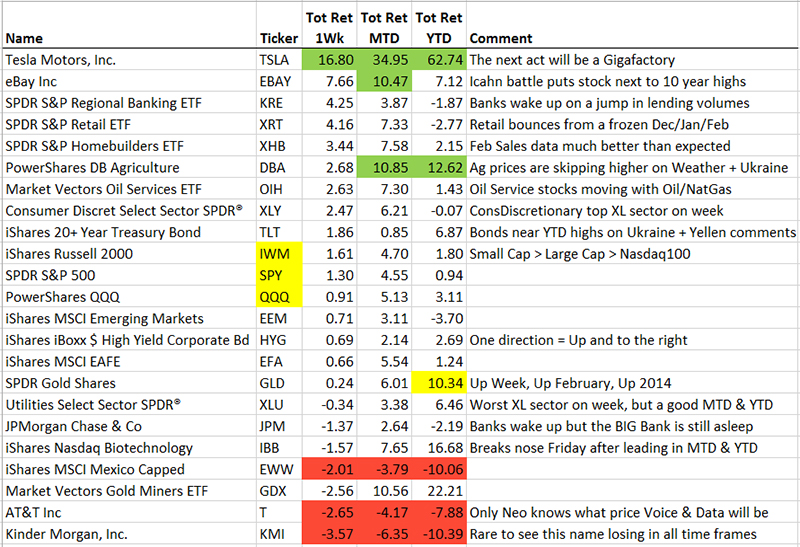
Getting stock specific, you knew that the future of Tesla was about more than just cars. Morgan Stanley is starting to focus in on the bigger transportation markets and the electric utility industries next…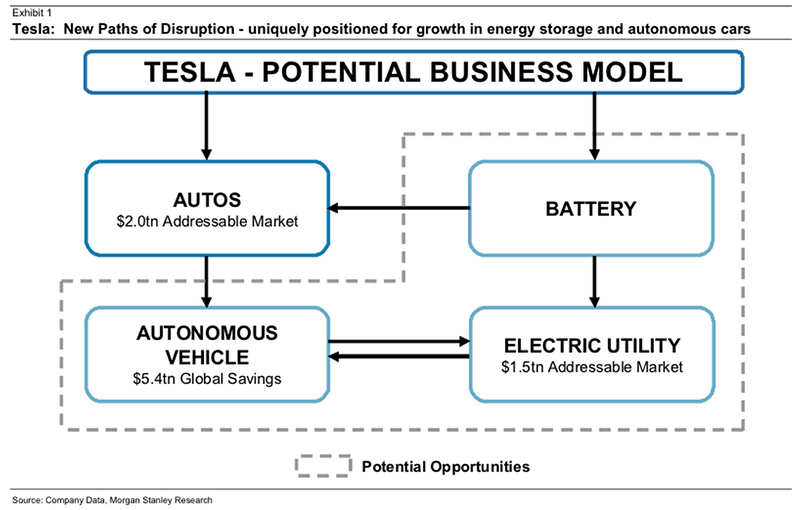
But it doesn’t hurt Tesla to have the top rated car in the market…
Best overall: Tesla Model S
Sure, you can talk about this electric luxury car’s blistering acceleration, razor-sharp handling, compliant ride, and versatile cabin, which can fit a small third-row seat. But that just scratches the surface of this technological tour de force. The Tesla is brimming with innovation. Its massive, easy-to-use 17-inch touch screen controls most functions. And with its totally keyless operation, full Internet access, and ultra-quiet, zero-emission driving experience, the Tesla is a glimpse into a future where cars and computers coexist in seamless harmony. Its 225-mile driving range and 5-hour charges, using Tesla’s special connector, also make it the easiest, most practical, albeit pricey, electric car to live with. Price as tested: $89,650
One positive surprise last week was in the housing data. And if you see how tight the market is in California, it won’t take much demand to send prices higher…
Southern California home building is stuck at historic lows, one of many factors conspiring against middle-class buyers in a recovery marked by high prices and low supply. Despite explosive price gains last year, builders and their Wall Street financiers remain hesitant to make big bets on the rebound. The slow construction is among many hurdles facing buyers seeking affordable homes. Cash-rich investors — many of them buying homes to rent out, rather than resell — have eaten into supply, especially at the lower end of the market. Meanwhile, many homeowners still aren’t selling because they lost too much equity during the housing crash. That may seem like an ideal opening for builders to put up new developments. But Southern California’s supply of new homes had dwindled to about 2,200 at the end of last year, compared with a peak of about 19,000 in 2006, when the housing market started to collapse, according to the Real Estate Research Council of Southern California at Cal Poly Pomona.
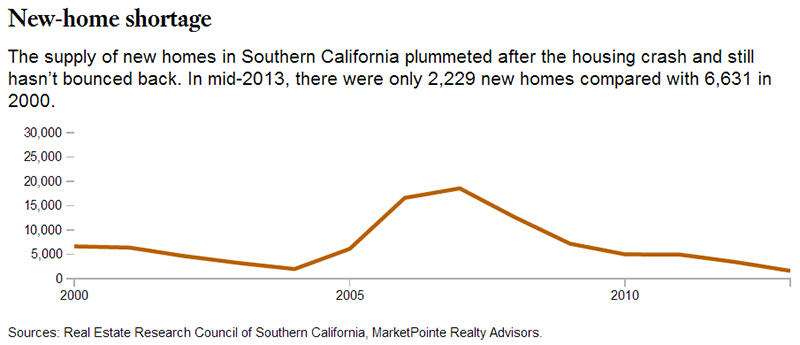
The housing market is even tighter in the Bay Area…
SAN FRANCISCO — Not long ago the pink house at 1829 Church Street, in the Glen Park neighborhood here, hit the market for $895,000. It sold for $1.425 million — $530,000 over the asking price — in less than two weeks. The story of this fixer-upper, with three bedrooms, two baths, linoleum floors and an Eisenhower-era kitchen, is in some ways the story of the moment in the city, where longtime residents complain that Silicon Valley money is basically ruining the place for everyone else… On one level, the technology industry and its riches have been very good to San Francisco. The unemployment rate is 4.8 percent, compared with 6.6 percent nationwide. Entire neighborhoods are being revitalized — or destroyed, depending on whom you talk to. To some, San Francisco is losing its soul as it gentrifies rapidly. There is reason to worry. Over the last decade, 75,000 people have moved to San Francisco, but only 17,000 new housing units have been built. Over the next 25 years, city officials project, 150,000 more people will arrive. “The city is surrounded by water on three sides, and there is nowhere for people to go,” said Glenn Kelman, chief executive of Redfin, an online real estate brokerage firm. Little wonder, then, that a feeding frenzy is underway in the housing market.
On the opposite side of tight housing markets there is New Jersey. This might be a good exercise to work through with some of your clients who aren’t rooted to a specific State…
When it comes to New Jersey’s taxes, it is a wonder any high earners live there at all. RegentAtlantic, which manages about $2 billion, analyzed data on tax rates on investments, property and estates in “Exodus on the Parkway,” to be released next week. The firm painted a picture of New Jersey as a state whose tax policies were causing it to lose residents at the point when their income and wealth were highest — and their taxes could support the most. In one example, the firm demonstrated the savings a hedge fund manager would have by moving to Greenwich, Conn., and not Summit, N.J., both about the same distance from New York City. If he had the choice of a $1 million house in either town, he would save $28,000 a year in property taxes by living in Greenwich. If he invested that savings each year for 30 years at an 8.5 percent return, he would have an additional $3.8 million.
Disclaimer: The information presented here is for informational purposes only, and this document is not to be construed as an offer to sell, or the solicitation of an offer to buy, securities. Some investments are not suitable for all investors, and there can be no assurance that any investment strategy will be successful. The hyperlinks included in this message provide direct access to other Internet resources, including Web sites. While we believe this information to be from reliable sources, 361 Capital is not responsible for the accuracy or content of information contained in these sites. Although we make every effort to ensure these links are accurate, up to date and relevant, we cannot take responsibility for pages maintained by external providers. The views expressed by these external providers on their own Web pages or on external sites they link to are not necessarily those of 361 Capital.
